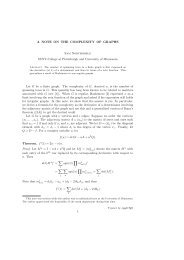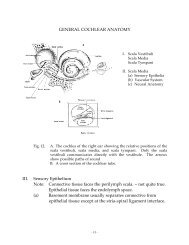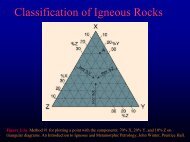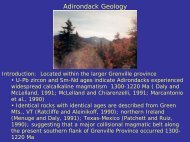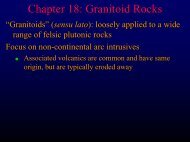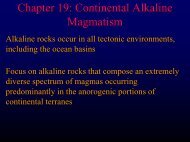Chapter 8: Major Elements - Faculty web pages
Chapter 8: Major Elements - Faculty web pages
Chapter 8: Major Elements - Faculty web pages
Create successful ePaper yourself
Turn your PDF publications into a flip-book with our unique Google optimized e-Paper software.
Metamorphic Facies<br />
Eskola (1915) , Finnish geologist, developed the<br />
concept of metamorphic facies:<br />
Defined as a range of P-T P T conditions over which a<br />
particular common mineral assemblage or range of<br />
mineral assemblages are stable.<br />
Rocks of wide range of compositions can be assigned<br />
to a facies
Metamorphic Facies<br />
Descriptive: : the relationship between the composition of<br />
a rock and its mineralogy<br />
metamorphic facies = a set of repeatedly associated<br />
metamorphic mineral assemblages<br />
<br />
find a specified mineral assemblage in the field, then<br />
a certain facies may be assigned to the area
Metamorphic Facies<br />
Interpretive: : the range of temperature and pressure<br />
conditions represented by each facies<br />
We can now assign relatively accurate temperature<br />
and pressure limits to individual facies
Metamorphic Facies<br />
Eskola (1920) proposed 5 original facies:<br />
Greenschist<br />
Amphibolite<br />
Hornfels<br />
Sanidinite<br />
Eclogite<br />
Each easily defined on the basis of mineral<br />
assemblages that develop in mafic (basaltic)<br />
rocks
Metamorphic Facies<br />
In his final account, Eskola (1939) added:<br />
Granulite<br />
Epidote-amphibolite<br />
Glaucophane-schist<br />
(now called Blueschist)<br />
changed the name of the hornfels facies to the<br />
Pyroxene Hornfels facies
Metamorphic Facies<br />
Several additional facies types have been proposed.<br />
Most notable are:<br />
Zeolite<br />
Prehnite-pumpellyite<br />
...resulting from the work of Coombs in the “burial<br />
metamorphic” terranes of New Zealand<br />
Fyfe et al. . (1958) also proposed:<br />
Albite-epidote epidote hornfels<br />
Hornblende hornfels
Metamorphic Facies<br />
Fig. 25-2.<br />
2.<br />
Temperature-<br />
pressure diagram<br />
showing the generally<br />
accepted limits of the<br />
various facies used in<br />
this text. Boundaries<br />
are approximate and<br />
gradational. The<br />
“typical” or average<br />
continental geotherm<br />
is from Brown and<br />
Mussett (1993). Winter<br />
(2001) An Introduction to<br />
Igneous and<br />
Metamorphic Petrology.<br />
Prentice Hall.
Metamorphic Facies<br />
Table 25-1. The definitive mineral assemblages<br />
that characterize each facies (for mafic rocks).<br />
Table 25-1. Definitive Mineral Assemblages of Metamorphic Facies<br />
Facies<br />
Definitive Mineral Assemblage in Mafic Rocks<br />
Zeolite zeolites: especially laumontite, wairakite, analcime<br />
Prehnite-Pumpellyite prehnite + pumpellyite (+ chlorite + albite)<br />
Greenschist chlorite + albite + epidote (or zoisite) + quartz ± actinolite<br />
Amphibolite hornblende + plagioclase (oligoclase-andesine) ± garnet<br />
Granulite orthopyroxene (+ clinopyrixene + plagioclase ± garnet ±<br />
hornblende)<br />
Blueschist glaucophane + lawsonite or epidote (+albite ± chlorite)<br />
Eclogite pyrope garnet + omphacitic pyroxene (± kyanite)<br />
Contact Facies<br />
After Spear (1993)<br />
Mineral assemblages in mafic rocks of the facies of contact metamorphism<br />
do not differ substantially from that of the corresponding<br />
regional facies at higher pressure.
It is convenient to consider metamorphic facies in 4 groups:<br />
1) Facies of high pressure<br />
blueschist and eclogite facies<br />
lower-T blueschist facies occurs in areas of low T,<br />
high P gradients, characteristic of subduction zones<br />
Eclogites indicate high P, moderate to high T<br />
gradients.
Metamorphic Facies<br />
2) Facies of medium pressure, moderate to high T<br />
Most metamorphic rocks now exposed at the surface<br />
of the Earth belong to the greenschist, amphibolite, , or<br />
granulite facies<br />
Greenschist and amphibolite facies conform to the<br />
“typical” geothermal gradient
Fig. 25-2.<br />
2.<br />
Temperature-<br />
pressure diagram<br />
showing the<br />
generally accepted<br />
limits of the<br />
various facies<br />
used in this text.<br />
Winter (2001) An<br />
Introduction to<br />
Igneous and<br />
Metamorphic<br />
Petrology.<br />
Prentice Hall.
Metamorphic Facies<br />
3) Facies of low pressure, high T = contact<br />
metamorphism<br />
Hornfels facies: albite-epidote epidote hornfels, hornblende<br />
hornfels, , and pyroxene hornfels<br />
Sanidinite facies is rare
Fig. 25-2.<br />
2.<br />
Temperature-<br />
pressure diagram<br />
showing the<br />
generally accepted<br />
limits of the<br />
various facies<br />
used in this text.<br />
Winter (2001) An<br />
Introduction to<br />
Igneous and<br />
Metamorphic<br />
Petrology.<br />
Prentice Hall.
Metamorphic Facies<br />
4) Facies of low metamorphic grades<br />
Zeolite and prehnite-pumpellyite<br />
pumpellyite facies<br />
Common in areas of burial or hydrothermal<br />
metamorphism
Metamorphic Facies<br />
Combine the concepts of isograds, zones, and facies<br />
Metamorphic maps typically include isograds that<br />
define zones and ones that define facies boundaries<br />
Determining a facies or zone is most reliably done<br />
when several rocks of varying composition and<br />
mineralogy are available
Facies Series<br />
A traverse up grade through a metamorphic terrane should<br />
follow one of several possible metamorphic field gradients<br />
and, if extensive enough, cross through a sequence of<br />
facies.
Figure 21-1. Metamorphic field gradients (estimated P-T conditions along surface traverses directly up metamorphic grade)<br />
for several metamorphic areas. After Turner (1981). Metamorphic Petrology: Mineralogical, Field, and Tectonic Aspects.<br />
McGraw-Hill.
Facies Series<br />
<br />
Miyashiro (1961) initially proposed five facies series,<br />
most of them named for a specific representative “type<br />
locality” The series were:<br />
1. Contact Facies Series (very low-P)<br />
2. Buchan or Abukuma Facies Series (low-P<br />
regional)<br />
3. Barrovian Facies Series (medium-P P regional)<br />
4. Sanbagawa Facies Series (high-P, moderate-T)<br />
5. Franciscan Facies Series (high-P, low T)
Facies Series<br />
High P/T series – occurs in subduction zones where normal<br />
isotherms are depressed<br />
zeolite – prehnite-pumpellyite<br />
pumpellyite – blueschist - eclogite<br />
Medium P/T series – characteristic of common orogenic<br />
belts (Barrovian(<br />
type)<br />
zeolite – prehnite-pumpellyite<br />
pumpellyite – greenschist – amphibolite-<br />
granulite<br />
Low P/T series – characteristic of high heat flow orogenic<br />
belts, rift areas and contact metamorphism<br />
Hornfels facies
Fig. 25-3.<br />
Temperature-<br />
pressure diagram<br />
showing the three<br />
major types of<br />
metamorphic<br />
facies series<br />
proposed by<br />
Miyashiro (1973,<br />
1994). Winter<br />
(2001) An<br />
Introduction to<br />
Igneous and<br />
Metamorphic<br />
Petrology.<br />
Prentice Hall.
Metamorphism of Mafic Rocks<br />
<br />
<br />
Most common minerals in mafic rocks show solid solution<br />
so metabasites have fewer phases than pelites.<br />
Result is fewer reactions and isograds<br />
<br />
Hydration of original mafic minerals required for the development<br />
of the metamorphic mineral assemblages of most facies<br />
<br />
If water is unavailable, mafic igneous rocks will remain largely<br />
unaffected in metamorphic terranes, even as associated sediments<br />
are metamorphosed.<br />
<br />
Coarse-grained intrusives are not permeable, and more likely to<br />
resist metamorphic changes<br />
<br />
Tuffs and graywackes are the most susceptible
Principal mineral changes result from breakdown of cpx and<br />
plagioclase:<br />
More Ca-rich<br />
plagioclases become progressively unstable<br />
at lower T<br />
General correlation between temperature and the maximum<br />
An-content of the stable plagioclase<br />
<br />
<br />
<br />
Metamorphism of Mafic Rocks<br />
At low metamorphic grades only albite (An 0-3 ) is stable<br />
In the upper-greenschist facies oligoclase becomes stable.<br />
Andesine and more calcic plagioclases are stable in the upper<br />
amphibolite and granulite facies<br />
The excess Ca and Al → calcite, an epidote mineral,<br />
sphene or amphibole depending on P-T-XP
Metamorphism of Mafic Rocks<br />
<br />
<br />
<br />
Clinopyroxene breaks down to a number of mafic minerals,<br />
depending on grade.<br />
Including chlorite, actinolite, hornblende, epidote, a<br />
metamorphic pyroxene, etc.<br />
The mafic(s) ) that form are commonly diagnostic of the<br />
grade and facies
Mafic Assemblages at Low Grades<br />
<br />
<br />
<br />
<br />
Zeolite and prehnite-pumpellyite pumpellyite facies<br />
Do not always occur - typically require unstable protolith<br />
Boles and Coombs (1975) showed that metamorphism of<br />
tuffs in NZ accompanied by substantial chemical changes<br />
due to circulating fluids, and that these fluids played an<br />
important role in the metamorphic minerals that were<br />
stable<br />
The classic area of burial metamorphism thus has a strong<br />
component of hydrothermal metamorphism as well
Mafic Assemblages of the Medium P/T<br />
Series: Greenschist, Amphibolite, and<br />
Granulite Facies<br />
<br />
<br />
The greenschist, amphibolite and granulite facies constitute<br />
the most common facies series of regional metamorphism<br />
The classical Barrovian series of pelitic zones and the<br />
lower-pressure Buchan-Abukuma series are variations on<br />
this trend
Greenschist, Amphibolite, Granulite Facies<br />
The zeolite and prehnite-pumpellyite pumpellyite facies are not present<br />
in the Scottish Highlands<br />
Metamorphism of mafic rocks is first evident in the<br />
greenschist facies, which correlates with the chlorite and<br />
biotite zones of the associated pelitic rocks<br />
Typical minerals include chlorite, albite, actinolite,<br />
epidote, quartz, , and possibly calcite, biotite, or<br />
stilpnomelane<br />
Chlorite, actinolite, and epidote impart the green color<br />
from which the mafic rocks and facies get their name
Greenschist Facies<br />
<br />
<br />
Greenschist, Amphibolite, Granulite Facies<br />
ACF diagram<br />
The most characteristic<br />
mineral assemblage of<br />
the greenschist facies is:<br />
chlorite + albite +<br />
epidote + actinolite ±<br />
quartz<br />
Fig. 25-6.<br />
ACF diagram illustrating<br />
representative mineral assemblages for<br />
metabasites in the greenschist facies. The<br />
composition range of common mafic rocks is<br />
shaded. Winter (2001) An Introduction to<br />
Igneous and Metamorphic Petrology. Prentice<br />
Hall.
Greenschist, Amphibolite, Granulite Facies<br />
Greenschist to amphibolite facies transition<br />
involves two major mineralogical changes<br />
1. Transition from albite to oligoclase<br />
2. Transition from actinolite to hornblende<br />
Both of these transitions occur at approximately<br />
the same grade, but have different P/T slopes
Amphibolite facies<br />
<br />
<br />
<br />
<br />
<br />
Greenschist, Amphibolite, Granulite Facies<br />
ACF diagram<br />
Typically two-phase Hbl-Plag<br />
Amphibolites are typically<br />
black rocks with up to about<br />
30% white plagioclase<br />
Garnet in more Al-Fe<br />
Fe-rich and<br />
Ca-poor mafic rocks<br />
Clinopyroxene in Al-poor<br />
poor-Ca-<br />
rich rocks<br />
Fig. 25-7.<br />
ACF diagram illustrating representative<br />
mineral assemblages for metabasites in the amphibolite<br />
facies. The composition range of common mafic rocks is<br />
shaded. Winter (2001) An Introduction to Igneous and<br />
Metamorphic Petrology. Prentice Hall.
Greenschist, Amphibolite, Granulite Facies<br />
The transition from amphibolite to granulite facies<br />
occurs in the range 650-700<br />
o C<br />
If aqueous fluid, associated pelitic and quartzo-<br />
feldspathic rocks (including granitoids) begin to<br />
melt in this range at low to medium pressures , so<br />
that migmatites may form and the melts may<br />
become mobilized<br />
Not all pelites and quartzo-feldspathic rocks reach<br />
the granulite facies as a result<br />
Amphibolite to granulite facies 650-700<br />
700°C;<br />
if H 2 O present, melting of pelites and<br />
quartzofeldspathic rocks may occur to form migmatites.
Transition to Granulite Facies<br />
Mafic rocks generally melt at somewhat higher<br />
temperatures<br />
If water is removed by the earlier melts the<br />
remaining mafic rocks may become depleted in<br />
water<br />
Hornblende decomposes and orthopyroxene +<br />
clinopyroxene appear<br />
This reaction occurs over a temperature interval of<br />
at least 50 o C
Fig. 26-19.<br />
Simplified petrogenetic grid for metamorphosed mafic rocks showing the location of several determined<br />
univariant reactions in the CaO-MgO<br />
MgO-Al<br />
2<br />
O 3<br />
-SiO<br />
2<br />
-H 2<br />
O-(Na<br />
2<br />
O) system (“C(N)MASH(<br />
C(N)MASH”). ). Winter (2001) An<br />
Introduction to Igneous and Metamorphic Petrology. Prentice Hall.
Greenschist, Amphibolite, Granulite Facies<br />
The granulite facies is characterized by the presence of a<br />
largely anhydrous mineral assemblage<br />
Metabasites critical<br />
mineral assemblage is<br />
orthopyroxene +<br />
clinopyroxene +<br />
plagioclase + quartz<br />
Garnet, minor<br />
hornblende and/or<br />
biotite may be<br />
present<br />
Fig. 25-8.<br />
ACF diagram for the granulite facies. The<br />
composition range of common mafic rocks is shaded. Winter<br />
(2001) An Introduction to Igneous and Metamorphic<br />
Petrology. Prentice Hall.
Origin of Granulite Facies<br />
The origin of granulite facies rocks is complex and<br />
controversial. There is general agreement, however, on two<br />
points<br />
1) Granulites represent unusually hot conditions<br />
Temperatures > 700 o C<br />
Depths should be in the vicinity of 500 o C, suggesting<br />
that granulites are the products of crustal thickening and<br />
excess heating
Greenschist, Amphibolite, Granulite Facies<br />
2) Granulites are dry<br />
Rocks don’t t melt due to lack of available water<br />
Granulite facies terranes represent deeply buried and<br />
dehydrated roots of the continental crust<br />
Fluid inclusions in granulite facies rocks of S. Norway<br />
are CO 2 -rich, whereas those in the amphibolite facies<br />
rocks are H 2 O-rich
Fig. 25-9.<br />
Typical mineral changes that take place in metabasic rocks during g progressive metamorphism in the<br />
medium P/T facies series. The approximate location of the pelitic c zones of Barrovian metamorphism are included<br />
for comparison. Winter (2001) An Introduction to Igneous and Metamorphic Petrology. Prentice Hall.
Fig. 25-2.<br />
2.<br />
Temperature-<br />
pressure diagram<br />
showing the<br />
generally accepted<br />
limits of the<br />
various facies<br />
used in this text.<br />
Winter (2001) An<br />
Introduction to<br />
Igneous and<br />
Metamorphic<br />
Petrology.<br />
Prentice Hall.
Mafic Assemblages of Hornfels Facies<br />
The facies of contact metamorphism are readily<br />
distinguished from those of medium-pressure<br />
regional metamorphism on the basis of:<br />
Andalusite and cordierite<br />
Textures and field relationships<br />
Mineral thermobarometry
Mafic Assemblages of the High P/T Series:<br />
Blueschist and Eclogite Facies<br />
The mafic rocks develop conspicuous and definitive<br />
mineral assemblages under high P/T conditions<br />
<br />
High P/T geothermal gradients characterize subduction<br />
zones<br />
<br />
Mafic blueschists are easily recognizable by their color,<br />
and are useful indicators of ancient subduction zones<br />
<br />
The great density of eclogites: : subducted basaltic oceanic<br />
crust becomes more dense than the surrounding mantle
Blueschist and Eclogite Facies<br />
Fig. 25-2.<br />
2. Temperature-<br />
pressure diagram showing the<br />
generally accepted limits of<br />
the various facies used in this<br />
text. Winter (2001) An<br />
Introduction to Igneous and<br />
Metamorphic Petrology.<br />
Prentice Hall.
Blueschist and Eclogite Facies<br />
<br />
The blueschist facies is characterized in metabasites by<br />
the presence of a sodic blue amphibole stable only at high<br />
pressures (usually glaucophane, but crossite or riebeckite<br />
is possible)<br />
<br />
The association of glaucophane + lawsonite is diagnostic.<br />
Albite breaks down at high pressure by reaction to jadeitic<br />
pyroxene + quartz:<br />
NaAlSi 3 O 8 = NaAlSi 2 O 6 + SiO 2 (reaction 25-3)<br />
Ab<br />
Jd<br />
Qtz
Blueschist and Eclogite Facies<br />
Fig. 25-10.<br />
ACF diagram illustrating<br />
representative mineral assemblages for<br />
metabasites in the blueschist facies. The<br />
composition range of common mafic rocks is<br />
shaded. Winter (2001) An Introduction to<br />
Igneous and Metamorphic Petrology. Prentice<br />
Hall.
Blueschist and Eclogite Facies<br />
Eclogite facies: mafic assemblage omphacitic pyroxene<br />
+ pyrope-grossular garnet<br />
Fig. 25-11.<br />
ACF diagram illustrating<br />
representative mineral assemblages for<br />
metabasites in the eclogite facies. The<br />
composition range of common mafic rocks is<br />
shaded. Winter (2001) An Introduction to<br />
Igneous and Metamorphic Petrology. Prentice<br />
Hall.
Pressure-Temperature<br />
Temperature-Time Time (P-T-t) Paths<br />
<br />
The facies series concept suggests that a traverse up grade<br />
through a metamorphic terrane should follow a<br />
metamorphic field gradient, , and may cross through a<br />
sequence of facies<br />
<br />
Progressive metamorphism: rocks pass through a series of<br />
mineral assemblages as they continuously equilibrate to<br />
increasing metamorphic grade<br />
<br />
But does a rock in the upper amphibolite facies, for<br />
example, pass through the same sequence of mineral<br />
assemblages that are encountered via a traverse up grade<br />
to that rock through greenschist facies
Pressure-Temperature<br />
Temperature-Time Time (P-T-t) Paths<br />
<br />
Pressure-Temperature<br />
Temperature-time time path, or P-T-t P t path: : The<br />
complete set of PT conditions that a rock may experience<br />
during a metamorphic cycle from burial to metamorphism<br />
to uplift and erosion
Pressure-Temperature<br />
Temperature-Time Time (P-T-t) Paths<br />
Metamorphic P-T-t P t paths may be addressed by:<br />
1) Observing partial overprints of one mineral assemblage<br />
upon another<br />
The relict minerals may indicate a portion of either the<br />
prograde or retrograde path (or both) depending upon<br />
when they were created
Pressure-Temperature<br />
Temperature-Time Time (P-T-t) Paths<br />
How do we determine metamorphic P-T-t P t paths<br />
2) Apply geothermometers and geobarometers to the core<br />
vs. rim compositions of chemically zoned minerals (e.g.,<br />
garnet) to document the changing P-T P T conditions<br />
experienced by a rock during their growth
Fig. 25-13a.<br />
Chemical zoning profiles across a garnet from the Tauern Window. After Spear (1989)
Fig. 25-13a.<br />
Conventional P-T P T diagram (pressure increases upward) showing three modeled “clockwise” P-T-t t paths<br />
computed from the profiles using the method of Selverstone et al. . (1984) J. Petrol., , 25, 501-531 531 and Spear (1989). After<br />
Spear (1989) Metamorphic Phase Equilibria and Pressure-Temperature<br />
Temperature-Time Time Paths. . Mineral. Soc. Amer. Monograph 1.
Pressure-Temperature<br />
Temperature-Time Time (P-T-t) Paths<br />
3) Rely on “forward” heat-flow models for various tectonic<br />
environments to compute more complete P-T-t P t paths, and<br />
evaluate them by comparison with the our interpreted<br />
results
Pressure-Temperature<br />
Temperature-Time Time (P-T-t) Paths<br />
<br />
Classic view: regional metamorphism is a result of deep<br />
burial or intrusion of hot magmas<br />
<br />
Plate tectonic view: regional metamorphism is a result of<br />
crustal thickening and heat input during orogeny at<br />
convergent plate boundaries (not simple burial)
Heat-flow models have been developed for:<br />
burial, progressive thrust stacking, crustal doubling<br />
by continental collision, and the effects of crustal<br />
anatexis and magma migration<br />
Higher Higher than the normal heat flow is required for<br />
typical greenschist-amphibolite<br />
medium P/T<br />
facies series<br />
Uplift Uplift and erosion has a fundamental effect on<br />
the geotherm and must be considered in any<br />
complete model of metamorphism
Fig. 25-12a.<br />
Schematic pressure-temperature<br />
temperature-time time paths based on a crustal thickening heat-flow model. The Al 2<br />
SiO 5<br />
phase diagram and two hypothetical dehydration curves are included. Facies boundaries, and facies series from Figs.<br />
25-2 2 and 25-3.<br />
Winter (2001) An Introduction to Igneous and Metamorphic Petrology. Prentice Hall.
Most examples of crustal thickening have the same general<br />
looping shape<br />
Paths such as (a) are called “clockwise” P-T-t t paths in the<br />
literature, and are considered to be normal for regional<br />
metamorphism
Fig. 25-12b.<br />
Schematic pressure-temperature<br />
temperature-time time paths based on a shallow magmatism heat-flow model. The Al 2<br />
SiO 5<br />
phase diagram and two hypothetical dehydration curves are included. Facies boundaries, and facies series from Figs.<br />
25-2 2 and 25-3.<br />
Winter (2001) An Introduction to Igneous and Metamorphic Petrology. Prentice Hall.
Fig. 25-12c.<br />
Schematic pressure-temperature<br />
temperature-time time paths based on a heat-flow model for some types of granulite facies<br />
metamorphism. . Facies boundaries, and facies series from Figs. 25-2 2 and 25-3.<br />
Winter (2001) An Introduction to<br />
Igneous and Metamorphic Petrology. Prentice Hall.
Pressure-Temperature<br />
Temperature-Time Time (P-T-t) Paths<br />
<br />
<br />
Broad agreement between the forward (model) and<br />
backward (geothermobarometry) techniques regarding P-P<br />
T-t t paths<br />
The general form of a path such as (a) therefore probably<br />
represents a typical rock during orogeny and regional<br />
metamorphism
Pressure-Temperature<br />
Temperature-Time Time (P-T-t) Paths<br />
1. Contrary to the classical treatment of<br />
metamorphism, temperature and pressure do not<br />
both increase in unison as a single unified<br />
“metamorphic grade.”<br />
Their relative magnitudes vary considerably during<br />
the process of metamorphism
2. P max and T max do not occur at the same time<br />
<br />
In the usual “clockwise” P-T-t t paths, P max occurs<br />
much earlier than T max .
T max should represent the maximum grade at which<br />
chemical equilibrium is “frozen in” and the<br />
metamorphic mineral assemblage is developed
This occurs at a pressure well below P max , which is<br />
uncertain because a mineral geobarometer should record<br />
the pressure of T max
“Metamorphic grade” should refer to the temperature and<br />
pressure at T max , because the grade is determined via<br />
reference to the equilibrium mineral assemblage
Metamorphic field gradient – PT change along traverse at Earth’s s surface<br />
up metamorphic grade<br />
Every rock follows a path of higher P and lower T than the final locus of<br />
T max -(P at T max ) points along the metamorphic field gradient



